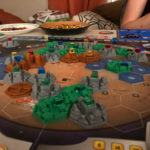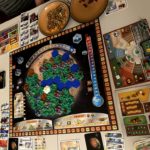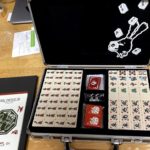Terraforming Mars, the big box game by FryxGames, is a long-time favorite board game at our kitchen table. As the name implies, it’s a game about making Mars habitable by humans. But, what if Terraforming Mars, but a fast-paced card game? That’s Ares Expedition.
Terraforming Mars: Ares Expedition shares a lot of elements with the board game. There’s a board representing Mars, divided into hexes. Players represent corporations building generation-long projects, which are cards in both games. Players have their own player boards, on which they track wealth and resources. What’s changed?

Ares Expedition is Terraforming Mars stripped to the bone. There are no cities or forests on the Mars map — only ocean tiles, which are flipped from desert to water as players complete projects that affect them. Instead of playing in turn, players play simultaneously. And in likely the largest change, not all possible phases are done every turn.
Phases are tracked on a series of Phase Tiles — Development, Construction, Action, Production and Research.
- Development — play Green project cards. These typically influence resource production.
- Construction — play Blue cards (those with some ongoing effect) or Red cards (science or engineering projects with immediate global effect).
- Action — activate Blue cards or perform standard actions
- Production — Harvest resources and get paid
- Research — Draw cards
Each player plays a phase card at the beginning of the turn. The phase cards played by everyone determines which phases are available. The player who played a phase card can take additional actions during that phase. Lastly, a player cannot play the same phase card twice in a row.
In Terraforming Mars, you draw cards and earn money every turn. In Ares Expedition, these things only happen if someone has played a Research or Production phase card. A lot of thought goes into playing the phase card each turn. If you think someone else might play a Production phase card, maybe it’s safe to play the Action phase card, and get your terraforming rating higher. Guess wrong, and maybe you’re broke now, and you won’t be able to play the Development cards in your hand.
Our Kickstarter version of the game came with sleeves for all the hundreds of cards, and double-layered player boards. We’ve found those indispensable in the original Terraforming Mars board game (they came with the Turmoil expansion), and were glad to see them here as well.
At the end of the night, we liked how fast the game is. The normal game takes about two hours for the four of us; we think we could halve that with Ares Expedition, now that we are comfortable with the game. This would maybe let us play it twice in one night.
We do miss the focus on what the other players are doing. The most we really interact directly with other players in AE is when we’re playing the Phase cards, as those influence what actions are possible in a turn. After that, it’s off to the races, and we’re playing our own boards.
The slower pace of TM lets every player have their place in the sun. Since there are no milestones or achievements in AE, and no jostling for space for one’s empire on the surface of the planet, there’s no real sense that we’re coming together to change the planet.
In our after-game discussion, we agreed that both games have their place. Ares Expedition does not replace Terraforming Mars; but it’s a nice way to get some of the flavor of the main game, a little faster.
At least they didn’t make it into a dice game or something.




